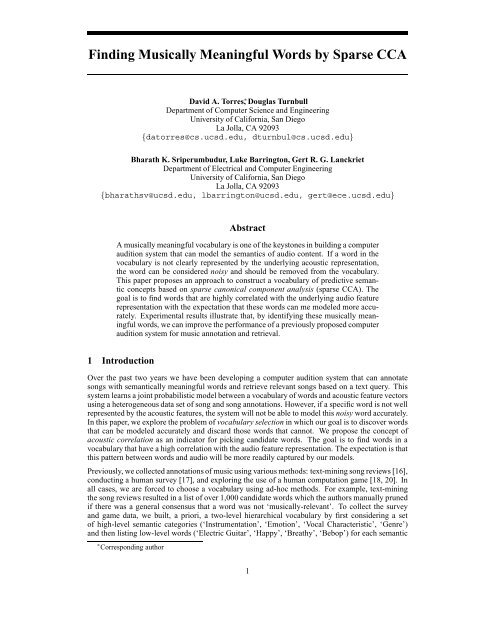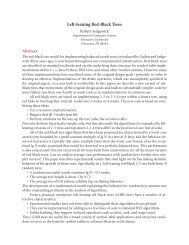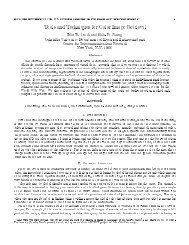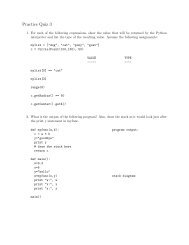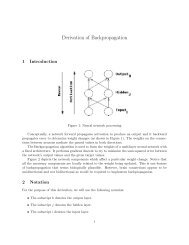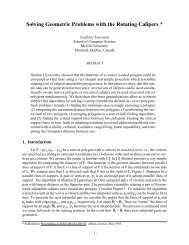Finding Musically Meaningful Words by Sparse CCA
Finding Musically Meaningful Words by Sparse CCA
Finding Musically Meaningful Words by Sparse CCA
You also want an ePaper? Increase the reach of your titles
YUMPU automatically turns print PDFs into web optimized ePapers that Google loves.
<strong>Finding</strong> <strong>Musically</strong> <strong>Meaningful</strong> <strong>Words</strong> <strong>by</strong> <strong>Sparse</strong> <strong>CCA</strong>David A. Torres ∗ , Douglas TurnbullDepartment of Computer Science and EngineeringUniversity of California, San DiegoLa Jolla, CA 92093{datorres@cs.ucsd.edu, dturnbul@cs.ucsd.edu}Bharath K. Sriperumbudur, Luke Barrington, Gert R. G. LanckrietDepartment of Electrical and Computer EngineeringUniversity of California, San DiegoLa Jolla, CA 92093{bharathsv@ucsd.edu, lbarrington@ucsd.edu, gert@ece.ucsd.edu}AbstractA musically meaningful vocabulary is one of the keystones in building a computeraudition system that can model the semantics of audio content. If a word in thevocabulary is not clearly represented <strong>by</strong> the underlying acoustic representation,the word can be considered noisy and should be removed from the vocabulary.This paper proposes an approach to construct a vocabulary of predictive semanticconcepts based on sparse canonical component analysis (sparse <strong>CCA</strong>). Thegoal is to find words that are highly correlated with the underlying audio featurerepresentation with the expectation that these words can me modeled more accurately.Experimental results illustrate that, <strong>by</strong> identifying these musically meaningfulwords, we can improve the performance of a previously proposed computeraudition system for music annotation and retrieval.1 IntroductionOver the past two years we have been developing a computer audition system that can annotatesongs with semantically meaningful words and retrieve relevant songs based on a text query. Thissystem learns a joint probabilistic model between a vocabulary of words and acoustic feature vectorsusing a heterogeneous data set of song and song annotations. However, if a specific word is not wellrepresented <strong>by</strong> the acoustic features, the system will not be able to model this noisy word accurately.In this paper, we explore the problem of vocabulary selection in which our goal is to discover wordsthat can be modeled accurately and discard those words that cannot. We propose the concept ofacoustic correlation as an indicator for picking candidate words. The goal is to find words in avocabulary that have a high correlation with the audio feature representation. The expectation is thatthis pattern between words and audio will be more readily captured <strong>by</strong> our models.Previously, we collected annotations of music using various methods: text-mining song reviews [16],conducting a human survey [17], and exploring the use of a human computation game [18, 20]. Inall cases, we are forced to choose a vocabulary using ad-hoc methods. For example, text-miningthe song reviews resulted in a list of over 1,000 candidate words which the authors manually prunedif there was a general consensus that a word was not ‘musically-relevant’. To collect the surveyand game data, we built, a priori, a two-level hierarchical vocabulary <strong>by</strong> first considering a setof high-level semantic categories (‘Instrumentation’, ‘Emotion’, ‘Vocal Characteristic’, ‘Genre’)and then listing low-level words (‘Electric Guitar’, ‘Happy’, ‘Breathy’, ‘Bebop’) for each semantic∗ Corresponding author1
category. In both cases, a vocabulary required manual construction and included some noisy wordsthat degraded the performance of our computer audition system.Presumably, one reason that certain words cause problems for our system is that the acoustic representationof these words is hard to model. This relates to the expressive power of our chosenaudio feature representation. For example, if we are interested in words related to long-term musicstructure (e.g., ‘12-bar blues’) and we only represent the audio using short-term ( < 1 sec) audiofeature vectors, we may be unable to model such concepts. Another example is words that relateto a geographical association (e.g., ‘British Invasion’, ‘Woodstock’) which may have strong culturalroots, but are poorly represented in the audio content.In this paper and in our latest research [15], given an audio feature representation, we wish toidentify words that are represented well <strong>by</strong> the audio content before we try to model them. Todo this we propose the use of an unsupervised method based on canonical correlation analysis(<strong>CCA</strong>) to measure acoustic correlation. <strong>CCA</strong> is a method of exploring correlations between differentrepresentations of some underlying data where these representations exist in two different featurespaces (vector spaces). For example, in this paper the information we wish to model, the semanticsof music, is represented as text labels and audio features. <strong>CCA</strong> has also been used in applicationsdealing with multi-language text analysis [19], learning semantic representations between imagesand text [2], and localizing pixels which are correlated with audio in a video stream [6]. Similarto the way principal component analysis (PCA) finds informative vectors in one feature space <strong>by</strong>maximizing the variance of projected data, <strong>CCA</strong> finds pairs of vectors within two feature spacesthat maximize correlation. Put another way, <strong>CCA</strong> finds a one dimensional subspace within eachfeature space such that the projection of data points onto their respective subspaces maximizes thecorrelation between these one-dimensional projections.Given music data represented in both a semantic feature space and an acoustic feature space, wepropose that these vectors of maximal correlation can be used to find words that are strongly characterized<strong>by</strong> an audio representation. Specifically, the <strong>CCA</strong> solution vector, or canonical component,that corresponds to the semantic representation is a mapping of vocabulary words to weights wherea high weight implies that a given word is highly correlated with the audio feature representation.We interpret high weights as singling out words that are “musically meaningful”. In other words,the underlying relationship (a correlation) between word and audio feature representation hints thata word may be more accurately modeled than a word for which no such relationship exists.Generally <strong>CCA</strong> returns a mapping of words to weights that is non-sparse, meaning that each wordwill be mapped to a non-zero weight. Hence, selecting good words from this vocabulary would bedone <strong>by</strong> thresholding the weights or <strong>by</strong> some other similar heuristic. It is desirable to remove suchan arbitrary step from the vocabulary selection process. This is done <strong>by</strong> imposing sparsity on thesolution weights, that is, we modify the <strong>CCA</strong> problem so that it tends to give solutions with few nonzeroweights, (sparse <strong>CCA</strong> [13]). This leads to a very natural criterion for selecting a vocabulary:throw away words with weights equal to zero.2 Acoustic Correlation with <strong>CCA</strong>Canonical Correlation Analysis, or <strong>CCA</strong>, is a method of exploring dependencies between data whichare represented in two different, but related, feature spaces. For example, consider a set of songswhere each song is represented <strong>by</strong> both a semantic annotation vector and an audio feature vector.An annotation vector for a song is a real-valued (or binary) vector where each element represents thestrength of association between the song and a word from our vocabulary. An audio feature vectoris a real-valued vector of statistics calculated from the digital audio signal. It is assumed that thetwo spaces share some joint information which can be captured in the form of correlations betweenthe data in the two feature spaces. <strong>CCA</strong> finds a one-dimensional projection of the data in each spacesuch that the correlations between the projections is maximized.More formally, consider two data matrices, A and S, from two different feature spaces. The rowsof A contain music data represented in the audio feature space A. The corresponding rows of Scontain the music data represented in the semantic annotation space S (e.g., annotation vectors).<strong>CCA</strong> seeks to optimizemaxw {wT a Σ as w s : wa T Σ aa w a = 1, ws T Σ ss w s = 1} (1)a∈A,w s∈S2
( )Σaa Σwhere Σ =asis the covariance matrix of [A|S].Σ sa Σ ssBy formulating the Lagrangian dual of Eq. (1), it can be shown that solving Eq. (1) is equivalent tosolving a pair of maximum eigenvalue problems,with λ being the maximum value of Eq. (1).Σ −1aa Σ as Σ −1ss Σ sa w a = λ 2 w a , (2)Σss −1 saΣ −1aa Σ asw s = λ 2 w s , (3)The solution vectors, w a and w s , in Eq. (1) are generally non-sparse, meaning that the coefficientsin the vectors tend to be non-zero. In many applications it may be of interest to limit the number ofnon-zero elements in the solution vector as this aids in the interpretability of the results. For example,in this application the solution vector w s can be interpreted as a mapping of words to weights wherea high weight implies that a given word is highly correlated with the audio feature representation. Inthe next section we impose sparsity on w s there<strong>by</strong> turning <strong>CCA</strong> into an explicit vocabulary selectionmechanism where words with zero weight (i.e., negligible correlation) are thrown away.2.1 <strong>Sparse</strong> <strong>CCA</strong>While PCA and its two-view extension, <strong>CCA</strong> are well studied and understood, to our knowledge,the sparse verion of <strong>CCA</strong> is not. Different algorithms [5, 23, 1, 13], both convex and non-convexhave been proposed for sparse PCA. Recently in [13], we proposed a general framework for solvingsparse eigenvalue problems using d.c. programming (difference of convex functions) [3] which weextend here to derive a sparse <strong>CCA</strong> algorithm.Consider the variational formulation of <strong>CCA</strong> in Eq. (1) which ( can be written ) as a generalized ( eigenvalueproblem, max x {x T Px : x T 0 Σas Σaa 0)Qx = 1}, where P =Σ sa 0, Q =0 Σ ss( )waand x = . Therefore, the variational formulation for sparse <strong>CCA</strong> is given <strong>by</strong>w smaxx {xT Px : x T Qx = 1, ||x|| 0 ≤ k}, (4)where 1 ≤ k ≤ n and n = dim(A) + dim(S). Eq. (4) is non-convex, NP-hard and thereforeintractable (see [13] for detailed discussion). A related problem to Eq. (4) is given <strong>by</strong>maxx {xT Px − ρ ||x|| 0 : x T Qx ≤ 1}, (5)where ρ > 0 is the penalization parameter that controls sparsity. Usually, ||x|| 0 is replaced <strong>by</strong> ||x|| 1to achieve convexity. However, in our setting, since P is indefinite, l 1 approximation does not yieldany computational advantage. So, we use a better approximation than l 1 , given <strong>by</strong> ∑ ni log |x i|,leading to the following program,n∑maxx {xT Px − ρ log |x i | : x T Qx ≤ 1}, (6)i=1This approximation has shown superior performance in sparse PCA experiments [13] and SVMfeature selection experiments [21]. With P being indefinite, Eq. (6) can be reduced to a d.c. programas{ () }n∑min µ||x|| 2 − x T [P + µI]x − ρ log |x i | : x T Qx ≤ 1 , (7)xwhere µ ≥ −λ max (P). Using the d.c. minimization algorithm (DCA) [14], we get the sparse <strong>CCA</strong>algorithm given <strong>by</strong> Algorithm 1, which is a sequence of quadratic programs. In our experiments, weimpose a sparsity constraint only on the solution in the the semantic space, S, therefore we need aconstraint on ||w s || 0 instead of the overall vector, ||x|| 0 . In such a case we have¯x ∗ = argmin¯xµ¯x T D 2 (x l )¯x − 2x T l [P + µI]D(x l)¯x + ||τ ◦ ¯x|| 1i=1s.t. ¯x T D(x l )QD(x l )¯x ≤ 1 (8)where D(x) = diag(x), (p ◦ q) i = a i b i and τ = [0, 0, dim(A) . . . , 0, ρ, ρ, dim(S) . . . , ρ] T .3
Algorithm 1 <strong>Sparse</strong> <strong>CCA</strong> AlgorithmRequire: Symmetric P, Q ≻ 0 and ρ > 01: Choosex 0 ∈ {x : x T Qx ≤ 1} arbitrarily2: repeat3:4: x l+1 = x l ◦ ¯x ∗5: until x l+1 = x l6: return x l , ¯x ∗¯x ∗ = argmin¯xµ¯x T D 2 (x l )¯x − 2x T l [P + µI]D(x l)¯x + ρ||¯x|| 1s.t. ¯x T D(x l )QD(x l )¯x ≤ 1For our purposes Eq. (8) becomes a vocabulary selection mechanism which takes as its input thesemantic and audio feature representations for a set of songs, S and A, and a penalization parameterρ that controls sparsity. The method returns a set of sparse weights w s associated with each word inthe vocabulary. <strong>Words</strong> with a weight of zero are removed from our modeling process.The non-zero elements of the sparse solution vector w s can be interpreted as those words whichhave a high correlation with the audio representation. Thus, in the experiments that follow, settingvalues of ρ and solving Eq. (8) reduces to a vocabulary selection technique.3 Representing Audio and Semantic DataIn this section we describe the audio and semantic representations, as well as describe the CAL500[17] and Web2131 [16] annotated music corpora that are used in our experiments. In both cases, thesemantic information will be represented using a single annotation vector s with dimension equalto the size of the vocabulary. The audio content will be represented as multiple feature vectors{a 1 , ...,a T }, where T depends on the length of the song.The construction of the matrices A and S to solve the sparse <strong>CCA</strong> follows: Each feature vectorin the music corpus is associated with the label for its song. For example, for a given song, weduplicate its annotation vector s for a total of T times so that the song-label pair may be representedas {(s,a 1 ), ..., (s,a T )}. To construct A we stack the feature vectors for all songs in the corpus intoone matrix. S is constructed <strong>by</strong> stacking all the corresponding annotation vectors into one matrix. Ifeach song has approximately 600 feature vectors and we have 500 hundred songs, then both A andS will have about 30,000 rows.3.1 Audio RepresentationEach song is represented as a bag-of-feature-vectors: we extract an unordered set of feature vectorsfor every song, <strong>by</strong> extracting one feature vector for each short-time segment of audio data.Specifically, we compute dynamic Mel-frequency cepstral coefficients (dMFCC) from each halfoverlapping,medium-time (∼743 ms) segment of audio content [9].Mel-frequency cepstral coefficients (MFCC) describe the spectral shape of a short-time audio frameand are popular features for speech recognition and music classification (e.g., [10, 7, 12]). Wecalculate 13 MFCC coefficients for each short-time (23 msec) frame of audio. For each of the 13MFCCs, we take a discrete Fourier transform (DFT) over a time series of 64 frames, normalize <strong>by</strong>the DC value (to remove the effect of volume) and summarize the resulting spectrum <strong>by</strong> integratingacross 4 modulation frequency bands: (unnormalized) DC, 1-2Hz, 3-15Hz and 20-43Hz. Thus, wecreate a 52-dimensional feature vector (4 features for each of the 13 MFCCs) for every 3/4 segmentof audio content. For a five minute song, this results in about 800 52-dimensional feature vectors.3.2 Semantic RepresentationThe CAL500 is an annotated music corpus of 500 western popular songs <strong>by</strong> 500 unique artists.Each song has been annotated <strong>by</strong> a minimum of 3 individuals using a vocabulary of 174 words. Wepaid 66 undergraduate music students to annotate our music corpus with semantic concepts. Wecollected a set of semantic labels created specifically for a music annotation task. We considered4
Top 3 words <strong>by</strong> semantic categoryAcoustic Correlationoverall rapping, at a party, hip-hop/rapemotion arousing/awakening, exciting/thrilling, sadgenre hip-hop/rap, electronica, funkinstrument drum machine, samples, synthesizergeneral heavy beat, very danceable, synthesized textureusage at a party, exercising, getting ready to go outvocals rapping, strong, altered with effectsBottom 3 words <strong>by</strong> semantic categoryAcoustic Correlationoverall not weird, not arousing, not angry/agressiveemotion not weird, not arousing, not angry/agressivegenre classic rock, bebop, alternative folkinstrument female lead vocals, drum set, acoustic guitargeneral constant energy level, changing energy level, notcatchyusage going to sleep, cleaning the house, at workvocals high pitches, falsetto, emotionalTable 1: Top and bottom 3 words <strong>by</strong> semantic category found <strong>by</strong> sparse <strong>CCA</strong> .135 musically-relevant concepts spanning six semantic categories: 29 instruments were annotatedas present in the song or not; 22 vocal characteristics were annotated as relevant to the singer ornot; 36 genres, a subset of the Codaich genre list [8], were annotated as relevant to the song or not;18 emotions, found <strong>by</strong> Skowronek et al. [11] to be both important and easy to identify, were ratedon a scale from one to three (e.g., ”not happy”, ”neutral”, ”happy”); 15 song concepts describingthe acoustic qualities of the song, artist and recording (e.g., tempo, energy, sound quality); and 15usage terms from [4], (e.g., “I would listen to this song while driving, sleeping, etc.”). The 135concepts are converted to the 174-word vocabulary <strong>by</strong> first mapping bi-polar concepts to multipleword labels (‘Energy Level’ maps to ‘low energy’ and ‘high energy’). Then we prune all words thatare represented in five or fewer songs to remove under-represented words. Lastly, we construct areal-valued 174-dimensional annotation vector <strong>by</strong> averaging the label frequencies of the individualannotators. Details of the summarization process can be found in [17]. In general, each element inthe annotation vector contains a real-valued scalar indicating the strength of association.The Web2131 is an annotated collection of 2131 songs and accompanying expert song reviewsmined from a web-accessible music database 1 [16]. Exactly 363 songs from Web2131 overlap withthe CAL500 songs. The vocabulary consists of 317 words that were hand picked from a list of thecommon words found in the corpus of song reviews. Common stop words are removed and theresulting words are preprocesses with a custom stemming algorithm. We represent a song review asa binary 317-dimensional annotation vector. The element of a vector is 1 if the corresponding wordappears in the song review and 0 otherwise.4 Experiments4.1 Qualitative ResultsWe solve a series of sparse <strong>CCA</strong> problems, each time increasing the sparsity parameterρ correspondingto the samantic space. This generates a series of vocabularies ranging in size. This effectivelygives us a “ranking” of words. The first three and last three words to be eliminated (i.e., the bottomthree and top three words, respectively) can be found in Table 1. The top three words were the lastwords to be eliminated in the sequence and are words that are highly correlated with audio content.The bottom three words were those removed in the sequence in the very first step, these wordspresumably have very low correlation with the audio content.1 AMG All Music Guide www.allmusic.com5
vocab.sz. 488 249 203 149 103 50# CAL500 words 173 118 101 85 65 39# Web2131 words 315 131 102 64 38 11%Web2131 .64 .52 .50 .42 .36 .22Table 2: The fraction of noisy web-mined words in a vocabulary as vocabulary size is reduced:As the size shrinks sparse <strong>CCA</strong> prunes noisy words and the web-mined words are eliminated overhigher quality CAL500 words.4.2 Quantitative Results4.2.1 Vocabulary Pruning using <strong>Sparse</strong> <strong>CCA</strong><strong>Sparse</strong> <strong>CCA</strong> can be used to perform vocabulary selection where the goal is to prune noisy wordsfrom a large vocabulary. To test this hypothesis we combined the vocabularies from the CAL500and Web2131 data sets and consider the subset of 363 songs that are found in both data sets.Based on our own informal user study, we found that the Web2131 annotations are noisy when comparedto the CAL500 annotations. We showed subjects 10 words from each data set and asked themwhich set of words were relevant to a song. The Web2131 annotations were not much better thanselecting words randomly to from the vocabulary, whereas CAL500 words were mostly consideredrelevant.Because Web2131 was found to be noisier than CAL500, we expect sparse <strong>CCA</strong> to filter out moreof the Web2131 vocabulary. Table 2 shows the results of this experiment. In the experiment weselect a value for the sparsity parameter ρ and obtain a sparse vocabulary. Then we record howmany noisy Web2131 words comprise the resulting vocabulary. The first column in Table 2 reflectsthe vocabulary with no sparsity constraints. Because the starting vocabularies are of different sizes,Web2131 initially comprises .64 of the combined vocabulary size. Subsequent columns in the tableshow the resulting vocabulary sizes as we increase ρ and, consequently, reduce the vocabulary size.Noisy Web2131 words are being discarded <strong>by</strong> our vocabulary selection process at a faster rate thanthe cleaner CAL500 vocabulary, upholding our prediction that vocabulary selection <strong>by</strong> accousticcorrelation should tend to remove noisy words. The results imply that Web2131 contains morewords that are uncorrelated with the audio representation. The different ways that these data setswere collected reinforces this fact. Web2131 was mined from a collection of music reviews; thewords used in a music review are not explicitly chosen <strong>by</strong> the writer because they describe a song.This is the exact opposite condition under which the CAL500 data set was collected, in which humansubjects were specifically asked to label songs in a controlled environment.4.2.2 Vocabulary Selection for Music RetrievalIn this experiment we apply our vocabulary selection technique to a semantic music annotationand retrieval system. In brief, our system estimates the conditional probabilities of audio featurevectors given words in the vocabulary, P(song|word). These conditional probabilities are modeledas Gausian Mixture Models. With these probability distributions in hand, our system can annotate anovel song with words from its vocabulary, or it can retrieve an ordered list of (novel) songs basedbased on a keyword query. A full description of this system can be found in [17].One useful evaluation metric for this system is the area under the receiver operating characteristic(AROC) curve. (A ROC curve is a plot of the true positive rate as a function of the false positiverate as we move down a ranked list of songs given a keyword input.) For each word, its AROCranges between 0.5 for a random ranking and 1.0 for a perfect ranking. Average AROC is used todescribe the performance of our entire system and is found <strong>by</strong> averaging AROC over all words inthe vocabulary.This final performance metric is brought down <strong>by</strong> words that are difficult to model. These are wordsthat have a low AROC so they bring the average AROC down. We propose to use sparse <strong>CCA</strong>to discover these difficult words (prior to modeling). (Alternatively, one can say that we are usingsparse <strong>CCA</strong> to keep “easy” words that exhibit high correlation, as oppsed to discarding difficultwords.)6
0.760.750.74sparse ccahuman agreementrandom0.73mean avg roc0.720.710.70.690.680.67180160140120100vocab size80604020Figure 1: Comparison of vocabulary selection techniques: We compare retrieval performance usingvocabulary selection <strong>by</strong> human agreement and acoustic correlation. The expected performance ofrandomly selecting words is also shown.In this experiment, we use sparse <strong>CCA</strong> to generate sparse vocabularies of full size ( about 180)down to 20. This is done <strong>by</strong> generating a sequence of vocabularies of progressivly smaller sizesas is described in Section 4.1. For each vocabulary the conditional probability densities associatedwith these words, or word models, are trained and the average AROC of the resulting word modelsis calculated on a test set of 50 songs held out separately from a training set of 450 songs from theCAL500 data set.Figure 1 shows that the average AROC of our system improves as sparse <strong>CCA</strong> selects vocabulariesof smaller size. Any increase from the left most point of the figure implies that the technique isremoving words which would have had a low AROC (thus bringing the average down). To reiterate,it is exactly the words with low AROC that we presume to be noisy and are difficult to model.Also shown in Figure 1 are the performance results of training based on two alternative vocabularyselection techniques. One is a random baseline in which a vocabulary is created <strong>by</strong> randomly selectingwords from the full vocabulary; the expected (mean) performance of this method is shown.The other technique is based on a heuristic we used in [15] in which we assigned to words a scorebased on the notion of human agreement. Then we select a vocabulary based on high agreementscores. (Details can be found in [15].) Briefly, because we have access to more than one humanannotation per song, we count how many times people agreed with the use of a particular word todescribe a song. For example, more subjects tended to agree on more objective instrumentationterms like “this song has a drum.”, as opposed to more subjective usage terms like “I would listento this song while waking up in the morning.” In this case “drum” would get a higher human agreementscore than “waking up,” and so we posit that it would be easier to model “drum” (it would havea higher AROC) than it would to model “waking up”. Our results show that vocabulary selectionusing acoustic correlation outperforms using this very logical heuristic of human agreement.It should be noted that the goal here is not to raise the performance of some arbitrary system, ratherthat raising the performance of this system suggests that our vocabulary selection method is removingwords that are difficult to model well and is selecting words that can be accurately modeled.Also, as a practical matter, our results show that this technique could be used, in a preprocessingstep, to inform as to which words to spend computational resources on when modeling.5 DiscussionWe have presented acoustic correlation via sparse <strong>CCA</strong> as a method <strong>by</strong> which we can automatically,and in an unsupervised fashion, discover words that are highly correlated with their audio featurerepresentations. Our results suggest that this technique can be used to remove “noisy” words that aredifficult to model accurately. This ability to filter poorly represented words also provides a means toconstruct a musically meaningful vocabulary prior to investing further computational resources inmodeling or analyzing the semantics of music as is done in our music annotation and retrieval system.Those interested in the application of vocabulary selection and music analysis are encouraged7
to view the work of Whitman and Ellis who have previously looked at vocabulary selection <strong>by</strong> trainingbinary classifiers (e.g., Support Vector Machines) on a heterogeneous data set of web-documentsrelated to artists and the audio content produced <strong>by</strong> these artists [22].References[1] A. d’Aspremont, L. El Ghaoui, M.I. Jordan, and G.R.G. Lanckriet. A direct formulation forsparse pca using semidefinite programming. Accepted for publication in SIAM Review, 2006.[2] David R. Hardoon, Sandor Szedmak, and Jogn Shawe-Taylor. Canonical correlation analysis;an overview with application to learning methods. Neural Computation, 2004.[3] R. Horst and N. V. Thoai. D.c. programming: Overview. Journal of Optimization Theory andApplications, 103:1–43, 1999.[4] Xiao Hu, J. Stephen Downie, and Andreas F. Ehmann. Exploiting recommended usage metadata:Exploratory analyses. ISMIR, 2006.[5] I. T. Jolliffe, N. T. Trendafilov, and M. Uddin. A modified principal component techniquebased on the LASSO. Journal of Computational and Graphical Statistics, 12:531–547, 2003.[6] Einat Kidron, Yoav Y. Schechner, and Michael Elad. Pixels that sound. In IEEE ComputerVision and Pattern Recognition, 2005.[7] Beth Logan. Mel frequency cepstral coefficients for music modeling. ISMIR, 2000.[8] Cory McKay, Daniel McEnnis, and Ichiro Fujinaga. A large publicly accessible prototypeaudio database for music research. ISMIR, 2006.[9] M. F. McKinney and J. Breebaart. Features for audio and music classification. ISMIR, 2003.[10] L. Rabiner and B. H. Juang. Fundamentals of Speech Recognition. Prentice Hall, 1993.[11] Janto Skowronek, Martin McKinney, and Steven ven de Par. Ground-truth for automatic musicmood classification. ISMIR, 2006.[12] M. Slaney. Semantic-audio retrieval. IEEE ICASSP, 2002.[13] Bharath K. Sriperumbudur, David A. Torres, and Gert R. G. Lanckriet. <strong>Sparse</strong> eigen methods<strong>by</strong> d.c. programming. In International Conference on Machine Learning, 2007.[14] Pham Dinh Tao and Le Thi Hoai An. D.c. optimization algorithms for solving the trust regionsubproblem. SIAM Journal of Optimization, 8:476–505, 1998.[15] D. Torres, D. Turnbull, L. Barrington, and G. Lanckriet. Identifying words that are musicallymeaningful. In ISMIR 07, 2007.[16] D. Turnbull, L. Barrington, and G. Lanckriet. Modelling music and words using a multi-classnaïve bayes approach. ISMIR, 2006.[17] D. Turnbull, L. Barrington, D. Torres, and G. Lanckriet. Towards musical query-<strong>by</strong>-semanticdescription using the CAL500 data set. In To appear in SIGIR ’07, 2007.[18] D. Turnbull, R. Liu, L. Barrington, D. Torres, and Gert Lanckriet. UCSD CAL technical report:Using games to collect semantic information about music. Technical report, 2007.[19] Alexei Vinokourov, John Shawe-Taylor, and Nello Cristianini. Inferring a sementic representationof text via cross-language correlation analysis. Advances in Neural Information ProcessingSystems, 2003.[20] Luis von Ahn. Games with a purpose. IEEE Computer Magazine, 39(6):92–94, 2006.[21] J. Weston, A. Elisseeff, B. Schölkopf, and M. Tipping. Use of the zero-norm with linear modelsand kernel methods. Journal of machine learning research, 2003.[22] B. Whitman and D. Ellis. Automatic record reviews. ISMIR, 2004.[23] Hui Zou, Trevor Hastie, and Robert Tibshirani. <strong>Sparse</strong> principal component analysis. Journalof computational and graphical statistics, 2004.8


